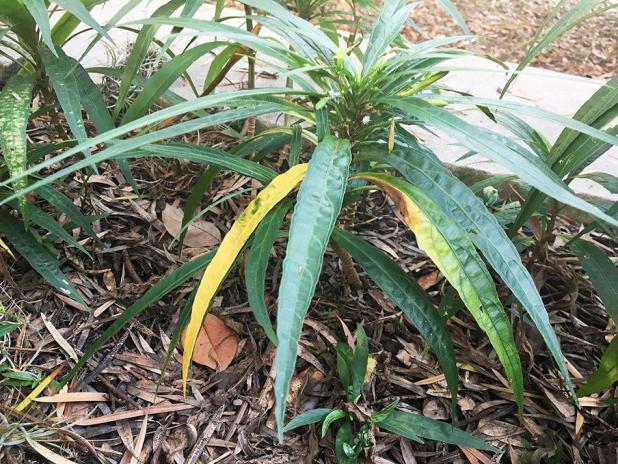
Nitrogen deficiency shows on older, lower leaves of ruellia, Mexican petunia.
—LSU AgCenter Photo/Kirk-Ballard
Get It Growing: Are plants nutrient deficient?
Your plant is not dead, but by the looks of it, it may not be among the living for long. How do you tell what’s going on? If water issues, genetic variation, mutations and viruses are not the cause, then look at nutrient deficiencies.
With the right tools and a good knowledge of plant nutrients, you can crack the case. The best way to diagnose a nutritional problem in plants is to trust your eyes and conduct both soil and tissue analyses, preferably all at the same time, to get the most accurate picture.
There are three main ways to determine a nutritional deficiency in plants.
A well-trained eye will be the first way to notice when a once-healthy plant is taking a turn for the worse. However, visual diagnosis can often be inaccurate in identifying the exact reason the plant is suffering. When diagnosing the problems, trust your eye, but use your tools to pinpoint the main problem.
The next way is with a soil test. The result from a soil test will indicate the concentration of nutrients in the soil and are a good next step in understanding any plant deficiency you may be seeing. But it will not identify the deficiencies within the actual plant itself.
The third and most accurate way to understand any nutrient deficiency in a plant is to test for nutrient concentrations in leaf tissue, ideally at the same time as a soil test is performed.
Performing both together will provide the current nutrient conditions and most accurate information on the content of the plant.
To prevent deficiencies, use a soil test to guide your fertilizer program. Plants need several nutrients to survive and thrive. The main ones are called macronutrients, and they include some of the common elements, including nitrogen (N), phosphorus (P), potassium (K) — the main three. Next are calcium (Ca), sulfur (S), magnesium (Mg), carbon (C), oxygen (O) and hydrogen (H).
Plants get the last three from the air. They also require to a lesser degree the micronutrients (or trace minerals) iron (Fe), boron (B), chlorine (Cl), manganese (Mn), zinc (Zn), copper (Cu), molybdenum (Mo) and nickel (Ni).
Most fertilizers available to home gardeners will include the main elements of nitrogen, phosphorus and potassium that you see on the formulations on the container. They are provided in a specific ratios of N-P-K in that order. For example, 10-10-10 signifies that the mix is 10% nitrogen, 10% phosphorus and 10% potassium.
To help figure out what is causing the symptoms your plant is displaying, ask yourself a few questions. When did you first notice the symptoms? Did they appear suddenly or gradually over time? Is the entire plant affected or only a certain area? Now take notice of which parts of the plant are affected. Is it the leaves, the fruit, the flowers, the branches or a combination?
Some of the most common symptoms of nutrient deficiencies are chlorosis, foliage color changes, overall plant stunting and sometimes necrosis. All can be caused by one or more deficiencies.
Let’s digest the symptoms one at a time.
Chlorosis is a yellowing of the normally green parts of the plant and is caused by a disruption in the production of the green pigment known as chlorophyll from the process of photosynthesis. Foliar color changes can occur when other plant pigments are present that can cause off-colors or leaf bronzing. Stunting is a noticeable delay in growth. Necrosis is when plant tissue begins turn brown to black as a result of localized cell death.
Here are some signs to look for, focusing only on the three main macronutrients: nitrogen, phosphorus and potassium.
Nitrogen deficiencies usually appear as yellowing on the oldest leaves or lower leaves of the plant. The yellowing typically starts at the leaf margins and moves inward.
The key to identifying nitrogen deficiency is noting the symptoms on the oldest leaves. An additional sign is stunted growth. When nitrogen is low, plant growth is slow and the new leaves are small. This is because nitrogen promotes green, leafy growth. Remedy this with the addition of compost for landscape beds and gardens or high-nitrogen fertilizer such as ammonium sulfate or calcium nitrate for container plants.
The next deficiency to consider is potassium. A potassium deficiency will cause purple tinting and brown edges on the leaves. You may also notice that the plant has fewer flowers and less fruit. Ultimately, potassium is important for both overall plant vigor and disease resistance. Use a potash fertilizer or potassium sulphate to provide more potassium.
Finally, phosphorus may be lacking if you see dull yellow foliage or slow overall plant growth. Phosphorus is needed for both healthy roots and shoots. When it is lacking, the plant will not grow or elongate roots or shoots efficiently.
Of the macronutrients, phosphorus is the least likely culprit as phosphorus is rarely in short supply in most soils. However, in areas with heavy clay soils and a great deal of annual rainfall, it is possible. You can remedy this issue with a superphosphate fertilizer or with bone meal at the recommended rate on the manufacturer’s label.
Several other nutrient deficiencies can cause symptoms in your plants. Nutrients also work together and against one another in some fashion.
One example of nutrient synergism is calcium and phosphorus. When present in the right ratio, calcium helps increase phosphorus uptake. Some nutrients compete for absorption. For example, iron and manganese can compete in what is called a nutrient antagonism — competition for absorption.
